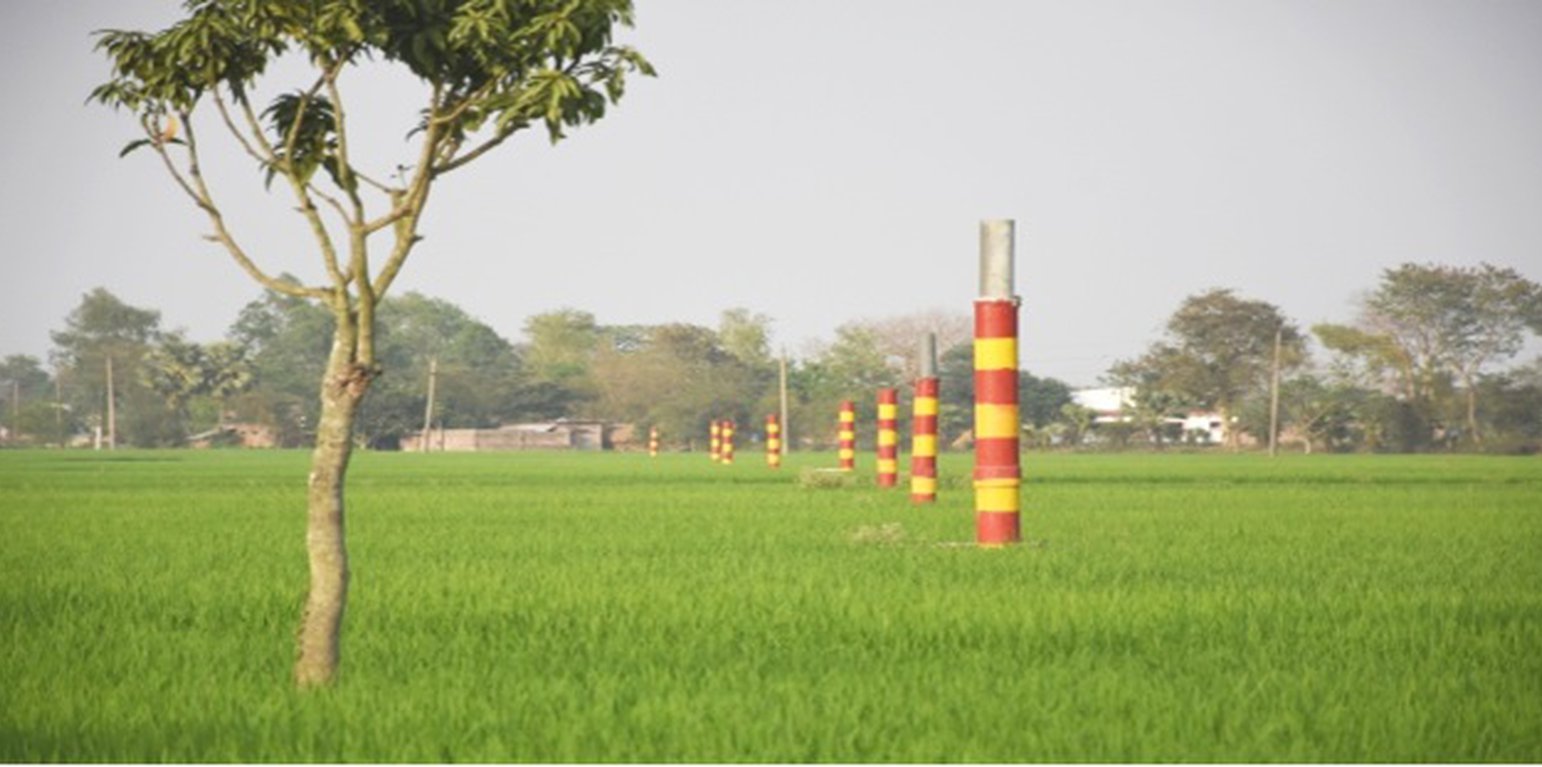Halting seasonal drought in Barind through efficient water resource management
(Bangladesh)
Barendra elakay Khara proshaman
Descrição
Introduction of sustainable water usage to prevent impacts of seasonal droughts in Barind region, Bangladesh
Barind is a drought-affected area of Bangladesh. It covers about 7,770 sq. km, that is 41% of the North Western part of Bangladesh, spreading over 16 districts of Rajshahi and Rangpur Division. It is one of the driest areas in Bangladesh with comparatively high temperatures - though cooler in the wet season from mid-June to October. Rainfall in the area varies from about 1500 mm to 2000 mm per annum. Temperature ranges from 4 degree Celsius to 44 degree Celsius. The area is at a comparatively higher elevation than the adjoining floodplains. There are two main terrace levels - one at 40m and the other between 19.8 and 22.9 m above mean sea level. The total cultivable area of Barind is about 583,000 ha, of which 34% is loamy, 10% is sandy, and 49% is clay: the remaining 7% is of other composition.
In the 1980s, the area was predominantly single cropped, and yields were poor and subject to seasonal drought, from late February to early May (up to the onset of pre-monsoon). No crops could be grown during the "rabi" season (November to May). The impacts of drought were severe and affected food insecurity and livelihoods. To address the situation, the Bangladesh Agricultural Development Corporation (BADC) under the Ministry of Agriculture (MoA) initiated two projects. One in 1985: The Barind Integrated Area Development Project and subsequently in 1992, the Barind Multipurpose Development Authority (BMDA) as a separate institutional entity. Both the projects focused on a new approach to water extraction, distribution and management practices at institutional level. Deep tubewells were installed and maintained by BMDA, rather than privately (which is often practiced in other parts of the country).
Deep tubewells (DTWs) were installed to abstract water from 15-20 meters, and water was initially distributed through open channels. Later, these were fitted with smart card–operated electric/solar pumps to develop a drought-resilient irrigation system Both projects have helped the Barind region reduce poverty and achieve self-sufficiency in rice. Without supplementary irrigation, there would be crop failure.
Since it was established, BMDA has focused on halting seasonal drought in Barind, and increased cropping intensity by providing irrigation through 15,800 DTWs in different districts. That reduced the cost of irrigation water for one bigha (0.1ha) from about $40 to <$20. On the other hand initiation of smart cards and buried pipelines for water distribution increased the efficiency of water use and facilitated revenue collection by the BMDA. However abstraction of groundwater (GW) for irrigation triggered another issue - drawdown of GW in the area, which even led to abandoning shallow tubewells (STW) used for drinking water.
In 2004 BMDA initiated another project, to lift surface water from the Padma river to ponds/canals/rivers in the main land after re-excavation. These sources are used as reservoirs and at the same time contribute to GW recharge generally. At the same time, usage of solar power instead of electricity is another means of reducing the cost of pumping water.
BMDA again installed 490 dugwells where STW or DTW could not be constructed. These dug wells are used for safe drinking water and small-scale irrigation. These measures have meant that, at present, the area avoids seasonal drought in most of the locations. Potatoes, "boro" and transplanted "aman" occupy more than 50% of the cultivable land. In addition, provision of safe drinking water and improved communications have boosted the local economy. The approach embraces various technologies including (1) tapping river water (from the Ganges, Mahananda and Tangan rivers0; (2) storing water in creeks or ponds; (3) distribution to farm land through subsurface irrigation pipes (buried pipelines); (4) use of low lift pumps (LLP) with solar energy support ; (5) prepaid water metering - usage of smart cards; (6) conversion of derelict water bodies to become effective water reservoirs ; (7) dug wells with solar power for water abstraction; (8) orchard plantations where both surface or groundwater are limited; (9) plantations of trees and horticultural crops along road and channels to change the land cover; (10) usage of compost to improve soil health. All of these contribute to land degradation neutrality (LDN) in one way or another.
Finally BMDA's approach is to boost productivity in the drought affected Barind through its projects, and encouraged communities to adopt diversified land use: previously much land remained fallow during most of the year outside the monsoon. Institutions like Department of Agricultural Extension (DAE) and many NGOs promote a variety of seasonal, annual and perennial crops in the area, the use of balanced fertilizer, plantation of high density fruit crops. The impact of the BMDA approach has greatly changed the drought-affected Barind.
Localização
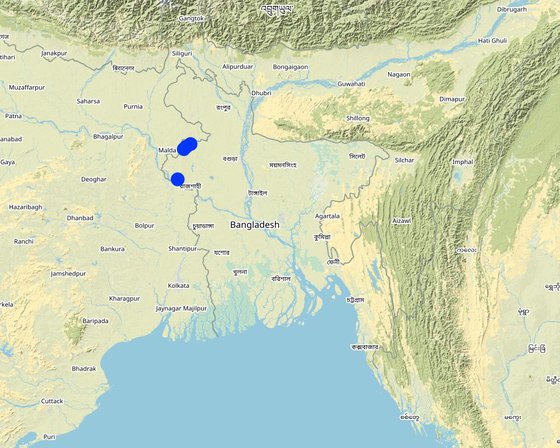
Localização: Rajshahi, Bangladesh
Geo-referência de locais selecionados
-
88.34253, 24.48579
-
88.45635, 25.02787
-
88.46016, 25.02759
-
88.5005, 25.0698
-
88.59865, 25.11608
Data de início: 1992
Ano de término: n.a.
Tipo de abordagem
-
Tradicional/Indígena
-
Iniciativa/inovação local recente
-
Baseado em projeto/programa
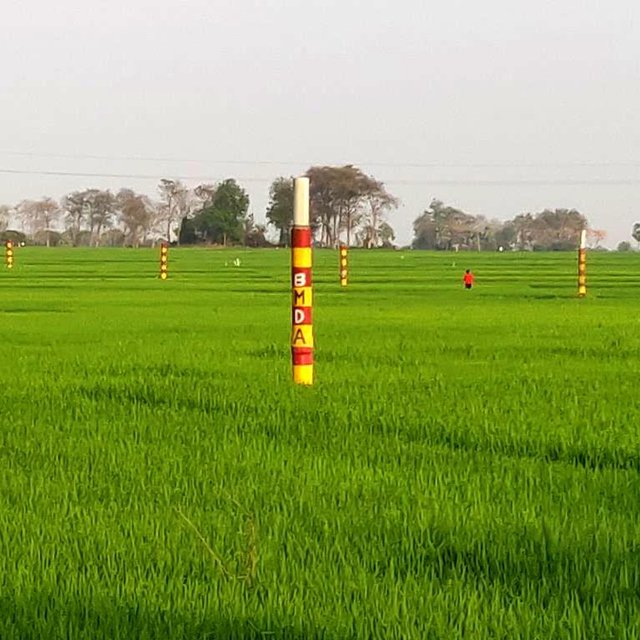
Buried pipeline in Barind. (ShoaibJU)
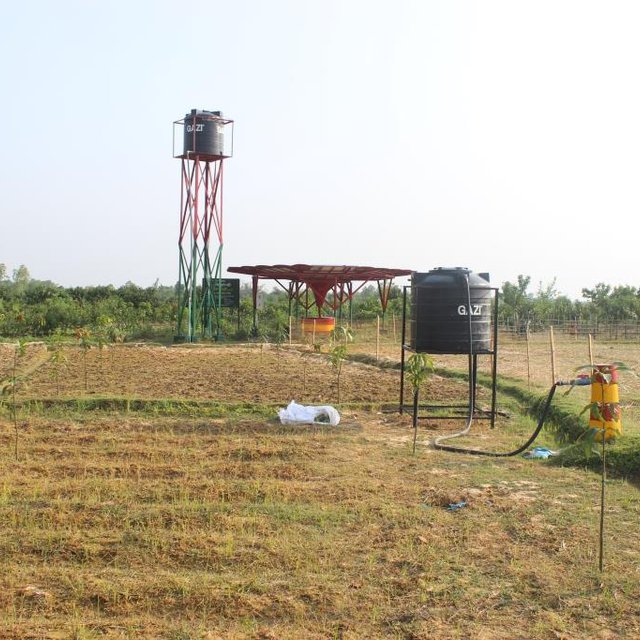
Solar powered dug well, used to support small-scale irrigation and safe drinking water for the community (ShoaibJU)
Objetivos de aproximação e ambiente propício
Principais metas / objetivos da abordagem
To provide irrigation water for cropping in dry season.
To increase cropping intensity in drought affected areas of Barind.
To manage land use or land cover in Barind.
To mobilize community on rational usage of soil and water resources.
Condições que permitem a implementação da Tecnologia(s) aplicada(s) sob a Abordagem
-
Normas e valores sociais/culturais/religiosos: Increased livelihood options and access to education, marketing, health services.
-
Disponibilidade/acesso a recursos e serviços financeiros: Increased access to financial institution.
-
Quadro institucional: All technical support provided by BMDA.
-
Colaboração/coordenção de atores: BMDA supports all action in related to irrigation, maintenance, water supply etc.
-
Quadro jurídico (posse de terra, direitos de uso da terra e da água): Lands owned by land users
-
Políticas: Land users are in the line of BMDA policies.
-
Governança da terra (tomada de decisões, implementação e aplicação): Traditional approach.
-
Conhecimento sobre GST, acesso a suporte técnico: Community has access to technical support.
-
Mercados (para comprar entradas, vender produtos) e preços: All inputs are available in the area.
-
Carga de trabalho, disponibilidade de força de trabalho: Available, people are getting work now.
Condições que dificultam a implementação da Tecnologia(s) aplicada(s) sob a Abordagem
Participação e papel das partes interessadas envolvidas
Partes interessadas envolvidas na abordagem e seus papéis
| Que partes interessadas/órgãos de implementação estavam envolvidos na abordagem? |
Especifique as partes interessadas |
Descreva o papel das partes interessadas |
| Usuários de terra/comunidades locais |
Men and women are involved in the process |
Growing crops as of their choice, for example: rice, fruits, vegetables or orchard trees. |
| Organizações comunitárias |
Farmers have societies, |
Influenced in choice of crops, etc. |
| Organização não governamental |
Several NGO s are functional in the area. |
Most of them are supporting credit and marketing facilities |
| Governo local |
Local institutions involved in the process |
Capacity building, advisory services on fertilizer usage, crop selection etc. |
Agência líder
BMDA is working as lead agency
Envolvimento do usuários de terra/comunidades locais nas diferentes fases da abordagem
Nenhum
Passivo
Apoio externo
Participativo
Automobilização
Iniciação/motivação
Farmers are using irrigation water for their crops supplied by BMDA and they pay revenue
Planejamento
Farmer nor the community are involved in the planning process
Implementação
Land users allow to set buried pipelines under their fields.
Monitoramento/avaliação
Land users are not involved in the M&E but they participate in the events organized.
None
Land users only choose their crops to be grown
Fluxograma
Barind Multipurpose Development Authoroty (BMDA) is the symbol of development in Barind area also of the Tista floodplain and the Old Himalayan piedmont plain.
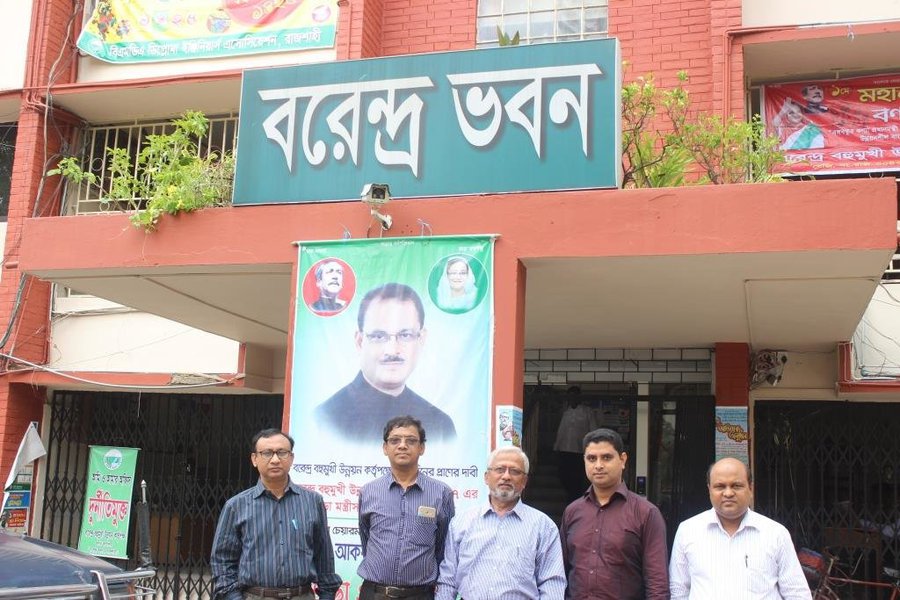
Autor: ShoaibJU
Tomada de decisão sobre a seleção da Tecnologia GST
As decisões foram tomadas por
-
Somente usuários da terra (iniciativa própria)
-
Principalmente usuários da terra, apoiados por especialistas em GST
-
todos os atores relevantes, como parte de uma abordagem participativa
-
Principalmente especialistas em GST, após consulta com usuários da terra
-
Somente especialistas em GST
-
Políticos/líderes
As decisões foram tomadas com base em
-
Avaliação de conhecimento bem documentado de GST (tomada de decisão baseada em evidências)
-
Resultados de pesquisa
-
Experiência pessoal e opiniões (não documentado)
Suporte técnico, reforço das capacidades e gestão do conhecimento
As seguintes atividades ou serviços têm sido parte da abordagem
-
Reforço das capacidades/ formação
-
Serviço de consultoria
-
Fortalecimento da instituição (desenvolvimento organizacional)
-
Monitoramento e avaliação
-
Pesquisa
Reforço das capacidades/formação
Foi fornecido treinamento às seguintes partes interessadas
-
Usuários de terra
-
Equipe de campo/consultores
Tipo de formação
-
Em exercício
-
Agricultor para agricultor
-
Áreas de demonstração
-
Reuniões públicas
-
Cursos
Assuntos abordados
Buried pipeline maitenance, good seed production, marketing etc.
Serviço de consultoria
Foi prestado um serviço de consultoria
-
nas áreas dos usuários da terra
-
Em centros permanentes
BMDA has field offices at each upazila to look after the system
Fortalecimento institucional
As instituições foram fortalecidas / estabelecidas
-
Não
-
Sim, pouco
-
Sim, moderadamente
-
Sim, significativamente
Descreva instituição, papéis e responsabilidades, membros, etc.
BMDA has it headquarters at Rajshai city and sub-offices at all "upazila" to where the pipeline extended.
Tipo de apoio
-
Financeiro
-
Reforço das capacidades/ formação
-
Equipamento
Mais detalhes
Monitoramento e avaliação
BMDA monitors groundwater levels regularly, and also the pipelines and other operational activities.
Financiamento e apoio material externo
Orçamento anual em USD para o componente GST
-
< 2.000
-
2.000-10.000
-
10.000-100.000
-
100.000-1.000.000
-
> 1.000.000
Precise annual budget: n.a.
Os seguintes serviços ou incentivos foram fornecidos aos usuários de terras
-
Apoio financeiro/material concedido aos usuários da terra
-
Subsídios para insumos específicos
-
Crédito
-
Outros incentivos ou instrumentos
Apoio financeiro/material concedido aos usuários da terra
All infrastructural establishment cost were born by BMDA
Parcialmente financiado
Totalmente financiado
Equipamento: Maquinário: Ferramentas
A mão-de-obra dos usuários da terra foi
-
Voluntário
-
Comida por trabalho
-
Pago em dinheiro
-
Recompensado com outras formas de apoio material
Outros incentivos ou instrumentos
Installation and maintenance cost borne by BMDA, but farmers have to pay for water through smart cards (Pre-paid).
Análise de impactos e declarações finais
Impactos da abordagem
Não
Sim, pouco
Sim, moderadamente
Sim, significativamente
A abordagem concedeu autonomia aos usuários locais de terra, melhorou a participação das partes interessadas?
Farmers are using irrigation water for their crops
A abordagem propiciou a tomada de decisão baseada em evidências?
As of now buried pipe lines for irrigation water supply are being adopting in many areas of the country.
A abordagem auxiliou os usuários da terra a implementar e manter as tecnologias de GST?
Usage of water rationally: BMDA installs control meters for each of the land user.
A abordagem melhorou a coordenação e a implementação economicamente eficiente da GST?
The approach has changed the Barind ecosystem at large.
A abordagem aprimorou o conhecimento e as capacidades dos usuários da terra para implementar a GST?
Land users enable to use irrigation water for growing crops of their choice
A abordagem aprimorou o conhecimento e as capacidades de outras partes interessadas?
Other local institutions in Barind area are involved in the system.
A abordagem construiu/fortaleceu instituições, colaboração entre partes interessadas?
Adoption of the irrigation system at all areas of the Barind.
A abordagem atenuou conflitos?
Stakeholders are enable to use water as they like.
A abordagem concedeu autonomia aos grupos social e economicamente desfavorecidos?
The area was resource poor before the 1990s. Now livelihoods of the community improved largely.
A abordagem melhorou a igualdade de gêneros e concedeu autonomia a mulheres e meninas?
Man and women are engaged themselves in their land and crops.
A abordagem encorajou os jovens/as próximas gerações de usuários de terra a se envolverem na GST?
Interventions with new crops, specially high value fruits etc in the area.
A abordagem melhorou as questões de posse de terra/diretos do usuário que inibiam a implementação das tecnologias de GST?
Land tenure system is traditional, where large areas are sublet or leased to the individuals or groups by the land owners.
A abordagem resultou em segurança alimentar aprimorada/nutrição melhorada?
The area produces a large amount of cereals, potatoes, vegetables, fruits etc.
A abordagem melhorou o acesso aos mercados?
Fruits and paddy rice have good markets.
A abordagem resultou em acesso melhorado à água e ao saneamento?
Safe drinking water where tubewells do not function, and sanitation also developed as the system.
A abordagem resultou em uso/fontes de energia mais sustentável?
Using solar power to abstract dug well water greatly facilitates the community.
A abordagem aprimorou a capacidade dos usuários da terra de adaptar-se a mudanças climáticas/extremos e atenuar os desastres relacionados com o clima?
Vegetative cover in the Barind has changed the ecosystem at large.
A abordagem resultou em emprego, oportunidades de renda?
Local people are having work everywhere of the Barind.
Principal motivação dos usuários da terra para implementar a GST
-
Produção aumentada
-
Lucro (lucrabilidade) aumentado, melhora da relação custo-benefício
-
Degradação do solo reduzida
-
Riscos de desastre reduzido
-
Carga de trabalho reduzida
-
Pagamentos/subsídios
-
normas e regulamentos (multas)/aplicação
-
Prestígio, pressão social/coesão social
-
Afiliação a movimento/projeto/grupo/rede
-
Consciência ambiental
-
Costumes e crenças, moral
-
melhoria dos conhecimentos e aptidões de GST
-
Melhoria estética
-
Atenuação de conflitos
Atividades de sustentabilidade de abordagem
Os usuários da terra podem sustentar o que foi implementado através da Abordagem (sem apoio externo)?
Buried pipeline irrigation has changed the Barind area greatly.
Conclusões e experiências adquiridas
Pontos fortes: visão do usuário de terra
-
More crops could be grown throughout the year,
-
Crop diversity is possible, annual, perenial or seasonal
-
Secure crop production
Pontos fortes: a visão do/a compilador/a ou de outra pessoa capacitada
-
Minimum loss of irrigation water
-
Surface (river) water usage minimize stress on ground water usage
-
Improved ground water recharge
-
Safe drinking water where tubewell is not available.
-
Usage of solar power for lifting water from dug well or for lifting water to buried pipeline
-
Introduction of water meters reduces misuse of irrigation water
Pontos fracos/desvantagens/riscos: visão do usuário de terracomo superar
-
The system could be implemented at single farmer level
Developing community approach with the support of the government
Pontos fracos/desvantagens/riscos: a visão do/a compilador/a ou de outra pessoa capacitadacomo superar
-
Very high pressure on land and soil resources
Lower water consumptive crops could be introduced
-
Severe soil nutrient depletion may develop
Use of manure/ compost or organic matter or crop rotation to enrich soil
Referências
Revisor
-
Rima Mekdaschi Studer
-
William Critchley
Data da documentação: 12 de Dezembro de 2021
Última atualização: 4 de Julho de 2022
Pessoas capacitadas
-
Jalal Uddin Md. Shoaib (shoaibju@gmail.com) - Especialista em GST
Descrição completa no banco de dados do WOCAT
A documentação foi facilitada por
Instituição
- Department of Environment (DoE) - Bangladesh
Projeto
- Establishing National Land Use and Land Degradation Profile toward Mainstreaming SLM Practices in Sector Policies (ENALULDEP/SLM)
Links para informação relevante que está disponível online
